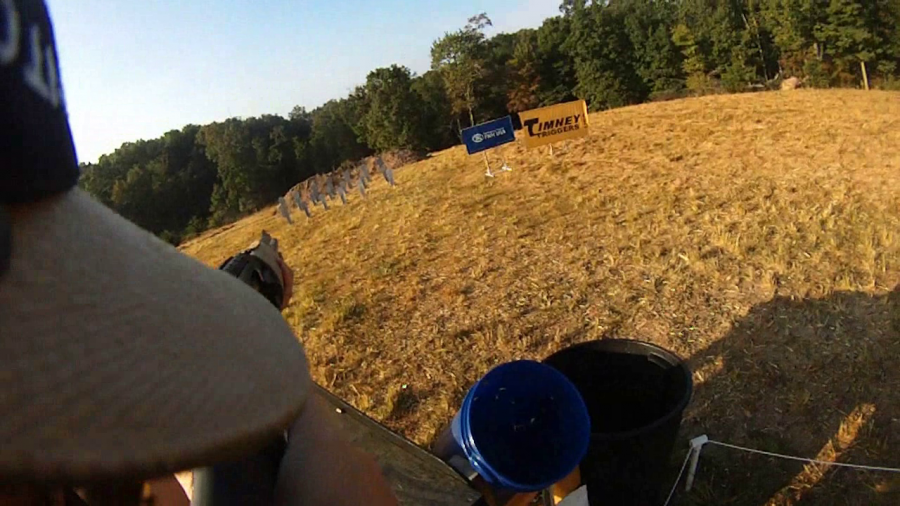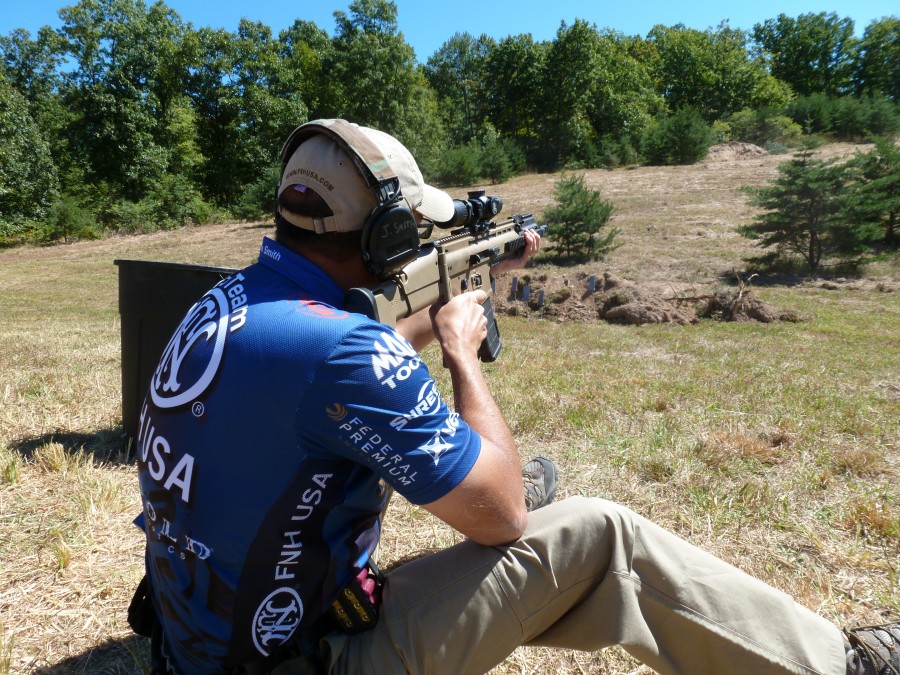For the average 3-gun competitor, things run pretty seamlessly at matches. You show up, you run through the stages with the help of the range officers and then, at some point, you see the final scores and go home loaded with prizes. But for those working the event, if you want to shoot in the match you need to do it during the “staff shoot” during the days preceding the competition. And while it’s the same basic outline, it’s a whole different beast . . .
The staff match is kinda like the beta test of the competition. The match staff is supposed to find any faults or flaws with the stage design and hammer out the final details before the competitors show up. As a result, the stages have a tendency to be a bit flawed.
It’s a massive pain in the ass for the staff since any major design changes that come out of it will trigger a re-shoot, and as we know re-shoots are a fickle mistress. But it’s a necessary evil and I’m fairly proud to say that thanks to my training at the hands of the rest of Team FNH USA this year, I was the cause of most of the issues uncovered at the staff match.
The way the stages were run was a little…wonky. It was an interesting system, but it meant that we didn’t run the stages in order. So while the videos are arranged in numerical order, I’ll cover them in the order in which I shot them – starting with stage 9.
For this stage, you start with your hands holding a knife above a dummy on a table, as if to stab them (Dexter-style), with an empty rifle slung, a holstered handgun, and a staged shotgun. After the buzzer, you drop the knife and engage the targets as you see fit.
The majority of the targets were pretty easy, but after looking at the stage for a minute you realize that the biggest challenge in the entire stage is hitting a pair of steel targets about 70 yards away. These targets consisted of two four inch flashing plates (they show a “flasher” card that pops out from behind the target when hit) in a larger metal IPSC-size non-scoring target. Despite the small size of the target, it wasn’t an impossible shot from 70 yards. But what made it incredibly difficult was that Larry Houck (match director and stage designer) had intended to have the shooters hit those targets offhand – from a standing position with no support whatsoever. It was obvious that the ability to hit those targets quickly would be required to score well on the stage.
This is where Larry screwed up.
At the meeting the night before, Larry Houck (Team FNH USA captain and match director for this match) had made the simple statement that the shooters could use whatever props and tables were within the shooting area to brace their guns (for longer targets and such), but anything outside the shooting area was off limits. The issue: he didn’t think that we would use the table that the dummy was staged on as a brace. But as soon as I saw that the table was within the shooting area, I was all over that.
I pointed it out to my fellow shooters in the squad, and every person on the squad proceeded to shoot the two small rifle targets with the barrel of our guns resting on the dummy’s legs. That is, until Larry came over and slowly shook his head. He moved the table outside the shooting area after we had finished, meaning we needed to re-shoot the stage.
Adding insult to injury, I mentioned to Jayson (within earshot of Larry) that there was still a way to shoot the small steel targets from the prone position from under the staging table at the end of the course. Larry then went over and stapled two no-shoot targets in that position, forcing you to shoot the targets offhand.
Like I said, these two steel targets were the key to the stage. Shoot them quickly and you did well. Shoot them slowly or miss and your scores took a nosedive. This led Jayson to an interesting strategy, gaming the stage for all its worth.
In this competition, a miss on a steel target less than 150 yards away is worth a 10 second penalty – a “failure to engage” is an added 5 seconds. Jayson’s plan was to fire two quick shots at the steel targets (eliminating the 10 seconds worth of FTE penalties) and then run the rest of the stage as quickly as possible. He believed that he could win, even with the penalties, by ignoring those targets. It’s an interesting strategy, and for someone who isn’t comfortable shooting offhand with their rifle it makes sense. But for me, veteran of the CMP service rifle matches, it was no issue whatsoever.
In the end, it didn’t really make a big difference. I beat Jayson by about 2 seconds, which is close enough as makes no difference.
The only real strategy question on this stage is what order to shoot the rifle targets. If you start with the steel targets and miss too much, then you won’t have enough ammunition for the paper targets without reloading (magazines were capped at 30 rounds). If you started with the paper targets you’d be sure to hit them all and have some left over for the steel, but then you didn’t have as solid of a shooting stance for the long range targets (what with the elevated heart rate from the rapid fire). It was a trade-off that I saw shot both ways, and depending on the shooter and their style it either helped or hindered their performance. There was one shooter who missed a whole lot on the long range steel and ran out of ammunition on the paper targets, then forgot to come back and shoot them with his handgun. It was a massive penalty, and one that could have been avoided.
The last trick on this stage was the small steel targets. They were arranged in such close proximity that you were almost guaranteed to hit more than one target with a single shotgun blast. For this stage, I borrowed a few turkey loads (high brass #6 shot) from a fellow competitor and ran the widest choke I had on hand. It paid off – I think I hit five in one go at one point.
When I ran the stage the first time, I had the top score in the squad. Removing the dummy, I only lost 2 seconds. Not bad, I’d think.
Stage 8 was next on the rotation, and in comparison to stage 9 it was pretty boring. You start with a slung rifle and a hand on a fishing rod, as if pulling in “the big one.” On the start signal, you drop the rod, load the rifle, and take out the targets as you see fit. There are some paper targets and steel targets to contend with, and the whole thing is on a downhill slope.
This is the second stage in a row that we needed to re-shoot, and the reason is that Jayson Smith played a little fast and loose with the rules. The paper only said that one hand needed to be on the fishing rod, so Jayson started the stage with the other hand on his rifle. This turned out to be a big no-no, and we had to re-shoot the stage after getting a little more detailed instructions on the start position.
The only real strategy question on this stage was whether you actually touched your shotgun at all. You were required to stage your loaded shotgun on a pickup table, but you weren’t required to use it. In fact, you could use your handgun for the entire rest of the stage if you wanted.
I tried it both ways, first running with the shotgun and then (for the re-shoot) running with handgun only. And despite my awful handgun shooting abilities, I didn’t lose any time when ignoring the shotgun. The trick is that when you use the shotgun, you have to take time to ditch it when it runs dry and draw your handgun, precious seconds that could be used to engage other targets. So while the shotgun might be quicker shot-to-shot, it isn’t quicker overall. Well, in this case, at least.
I really wish I had remembered that lesson during the later stages. . .
Stage 7 was a nifty design, and one that caught at least one of our team members.
You start in the batter’s box with your bat in hand, as if about to hit a pitch. On the start signal, you run to first base where you use either a staged handgun or shotgun to take out some steel plates and a slug target. Then, you move to second base where you engage six steel targets with the rifle. Finally, it’s up to third base where the last firearm (either handgun or shotgun, depending on what’s on first) mops up the final targets.
The catch: you need to fire every shot while your foot is physically touching a white “base.”
Tate Moots didn’t quite catch that part of the stage brief, so when he shot the stage he paid no attention to the white squares under his feet. As a result, he racked up 19 procedural penalties at 20 seconds a pop. It was a mistake that sent him immediately to the bottom of the list for that stage, and one that we weren’t eager to repeat.
The issue with this stage, like stage 9, was the long range targets. They were relatively small plates at around 70 yards, and depending on your skill level you had some options. The fastest way to shoot the targets (and the way I did it) was to stand and shoot them offhand. But if you weren’t as confident with your rifle or your skills, you could kneel and shoot from a more stable position. The problem is that if you kneel, you instantly lose about 10 seconds between getting into position and getting back out again.
Where I really struggled on this stage was the handgun shooting. My handgun skills are nowhere near where they need to be, so I kept missing the steel targets. Especially the longer range slug target (which was optional slug or handgun), it took me like five rounds to hit the damned thing. It’s something that I’ll need to work on in the off season, probably by hitting every USPSA match I can find.
The stages we shot first ended up being the easiest stages of the competition. From here, it only became harder.











I love reading these, Nick. They’re getting better every time, too — pretty soon you’re going to be the in-demand, go-to guy for 3-gun match write-ups on all the gun sites.
Got to try me some of that. Maybe I can so some local next year if I can get some time.
Hope you had a good time Nick. As a member at Peacemaker, I love seeing the coverage of the FNH match.
If you have herbal ed treatment ever had. No Negative effectsThe toop male
enhancement supplement has been blended with very effective herbs and natural components.
Comments are closed.